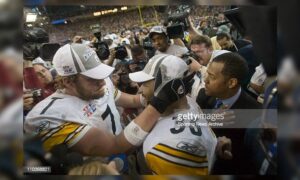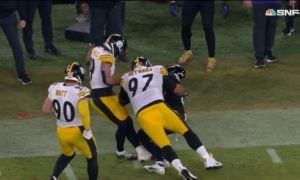Pittsburgh Steelers quarterback Ben Roethlisberger’s game has never been accused of being pretty, nor has it ever been overly cerebral, particularly in his early years.
Although his ability to read and manipulate defenses has improved, there’s little argument that much of his success over the years can be attributed to his size helping him extend and create plays.
It’s why you don’t see his name on the Pro Bowl roster every year. He may never lead the league in passing yards or touchdowns thrown. But there’s no denying that through the years his defining attribute has been finding ways to win games.
This was especially true earlier in his career. He helped lead the Steelers to a 15-1 season as a rookie. His heady tackle after a shocking Jerome Bettis fumble against the Indianapolis Colts in 2005 helped preserve the organization’s first Super Bowl in decades.
In both Super Bowl years, in fact, Roethlisberger led the Steelers to five fourth-quarter comebacks.
Yet there have only been four of those in the past three seasons, and the Steelers have only won 28 games in that span.
Some have wondered lately if Roethlisberger has lost some of that late-game magic that helped make him one of the best quarterbacks in the league.
Of course, Romo has 11 fourth-quarter comebacks over the last three seasons. Still, among active quarterbacks, Roethlisberger trails only Peyton Manning, Tom Brady, and Eli Manning in fourth-quarter comebacks, with 23 in his career.
Here is what Brooks wrote about Roethlisberger on the list:
There’s no doubt Big Ben deserves a spot on this list, given his penchant for clutch play throughout his career. The 11th-year pro has directed 23 fourth-quarter comebacks during his tenure and single-handedly carried an offense that’s struggled with pass protection in recent years. Roethlisberger’s numbers in two-minute situations (98.9 passer rating and 5:1 TD-to-INT ratio in 2013) speak for themselves, but it’s his innate ability to extend plays without turning the ball over that really stands out. Big Ben has mastered the art of avoiding and escaping rushers while keeping his eyes downfield, making him nearly impossible to defend in late-game situations, when defensive coaches are prone to lean on soft zone coverage (i.e., the prevent defense).
The Steelers’ defense isn’t quite as strong as it used to be, even with the new pieces that have been added through free agency and the draft. The offense has gotten younger and less experienced, and they will need Roethlisberger’s veteran guidance—and late-game heroics—more than ever.







